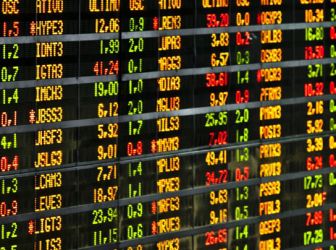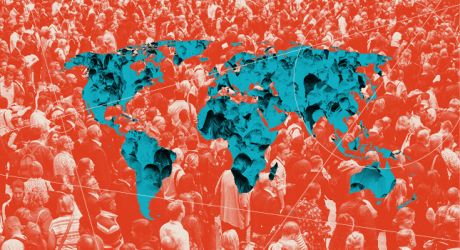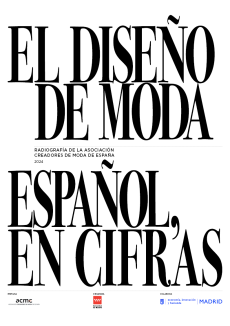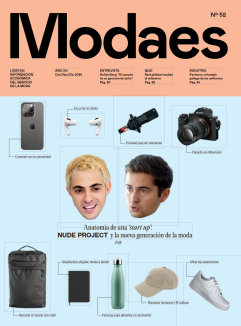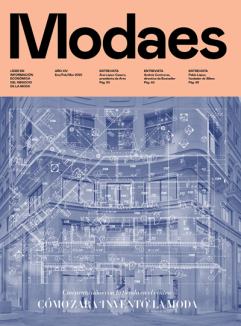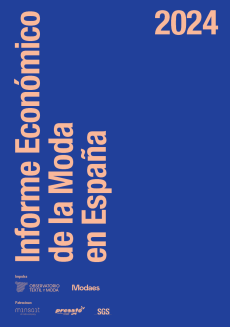Achim Berg: “Size is not in itself a guarantee for success”
Berg (Wiesbaden, Germany, 1972), after finishing his studies and completing various internships, he joined the firm McKinsey, where he developed a nearly thirty-year career, which he just concluded to embark on a solo journey.


10 oct 2024 - 18:25
Achim Berg (Wiesbaden, Germany, 1972) says that he found his passion for fashion in a completely unexpected way. After finishing his studies and completing various internships, he joined the consultancy firm McKinsey in 2000, where he developed a nearly thirty-year career, which he just concluded to embark on a solo journey. He says that when he started his career as a consultant, working for a fashion company was considered “something frivolous.” “Fashion was seen as a small business, an industry with low margins and much less sophisticated than the rest of retail,” he explains. His mentor recommended that he focus on less cyclical industries like the chemical sector, but he didn’t listen and has since worked with the world’s leading fashion companies. With a new chapter about to begin in which he wants to theorize about the future of the fashion industry, he states that size is not a guarantee for success, that prices will rise, or that sometime consumers don’t know what they want. But here’s a piece of advice for executives: “If you don’t want your business to be between a rock and a hard place, you’d better get serious about sustainability.”
You’re preparing a book about the future of the fashion industry, so the first question is almost mandatory: what will fashion be like in the future?
Well, that’s what I’m going to try to find out. The book will have two parts: the first one will focus on the period between 2000 and 2025 to understand the transformation the sector has undergone, how groups like H&M or Inditex, as well as sports players like Nike or Adidas, have grown significantly. At the same time, in these years, many major names in the sector have disappeared. I would also like to understand and research what the next decade will be like, i.e., up until 2035. We have seen great consolidation in the sector over the past ten years: if you think about value creation, the twenty largest players have generated 80% of the profits in the entire sector. Will this trend continue? Can small brands compete in this market? What role will sustainability play? And what about digitalization?
“All changes create opportunities for brands”.
Industries like film or music have changed drastically over the past twenty years. Do you foresee such a big change in fashion, or has it already happened?
There have been, and still are, many changes. If you look at the last fifteen years, just think of e-commerce. I still remember when, at the beginning, many people thought it wasn’t real, that it would be, at most, the size of a company’s biggest store and that it was a completely separate business. Relatively few operators saw the opportunity and jumped in. Or we could talk about the second-hand market. I’m not entirely convinced yet; I’m a bit skeptical, but resale is a reality. And it’s a massive change for the industry, with something that has gone from being called second-hand or vintage to pre-loved. Second-hand will make up 20% of the fashion market at some point, although the business will belong more to platforms than to brands. But the consumer wants it, so no one is going to stop it. It will happen, and that’s it. So, a massive change has occurred in the sector. We’ve seen a big shift compared to other industries, and more will change in the next ten and twenty years. But in the end, people like to dress up, not just have to dress. Fashion and clothing are a way of expressing oneself, of positioning oneself in society. This won’t disappear, although many changes are still to come.
Who or what will be the disruptors in the fashion industry?
It’s difficult to name specific people or brands, but if we look at the past ten, fifteen, or twenty years, we’ll identify certain themes. For example, sportswear, which is based on a cultural change, as people probably have more free time, more disposable income, and are also more aware of health and well-being. As a result, sports brands and retailers in the sector have seen significant growth. Another disruptor could be digitalization, which has changed the way we shop with e-commerce. All these changes create opportunities for brands. Or think about luxury, which twenty-five years ago wasn’t even considered an industry; no one knew French and Italian brands, which were relatively small back then. Today, luxury includes some of the world’s most valuable brands, again because people have more disposable income and because luxury has become a way to stand out, while a growing middle class has emerged in the West, and emerging markets have developed.
What is Shein? Is it a disruptor or a temporary phenomenon?
It’s definitely a disruptor and a very relevant force in the market right now. It is what I would call the third generation of fast fashion, which is very interesting because, if you think about it, five years ago in the fashion industry, everyone was convinced that fast fashion was dead. That it was too fast, not sustainable, and was going to collapse... Shein proves that if you have a compelling offer, a good go-to-market strategy, and, in its case, a spectacular front end linked to gamification, you are at another level and can create a massive business in a short period of time. Still, there’s not much public information yet, and we’re all waiting for the IPO prospectus to be published, if there’s an IPO at all. Shein’s size and profitability are impressive, but above all, it’s a model of massive business innovation. In a way, Shein is similar to Inditex; it’s also an innovation for the business model, and of course, it’s reaching consumers. It’s also using some loopholes regarding taxes, and there’s a lot of debate about sustainability. If the loopholes disappear, they will have to adapt their business model.
“In a way, Shein is similar to Inditex; it’s also an innovation for the business model”
How will consumers buy fashion in the future?
We need to differentiate between the Western world and established markets, and emerging countries. And the reality is that most Western markets are saturated. Closets are full, and on average, 20% of garments haven’t even been worn. So it’s much more about buying out of desire than necessity, which means it’s entertainment and a form of self-expression. On the other hand, since Covid, we’re seeing that per capita fashion consumption is declining, as a result of saturation and the fact that the pandemic convinced many people in the Western world that vacations and travel are a priority, so fashion is competing with other forms of entertainment. If you want to go on vacation, you'll cut back on fashion before you cut back on food.
In this context, in markets like Spain, we find that large groups continue to grow, but medium and small companies are struggling. Is polarization increasing?
We are witnessing a general polarization of the industry. And it is very interesting to see how it is evolving. In Spain or Northern Europe, even in Germany, we typically find a handful of companies exceeding one or two billion euros, either because the country is able to generate businesses of that size or because the companies have found ways to tap into international opportunities. Size generates economies of scale that allow investment in different aspects of the business: globalization, digitization, sustainability... For smaller brands, it's increasingly difficult to survive. But there are also many examples of large operators struggling and not delivering good results: size is not a guarantee of success in itself.
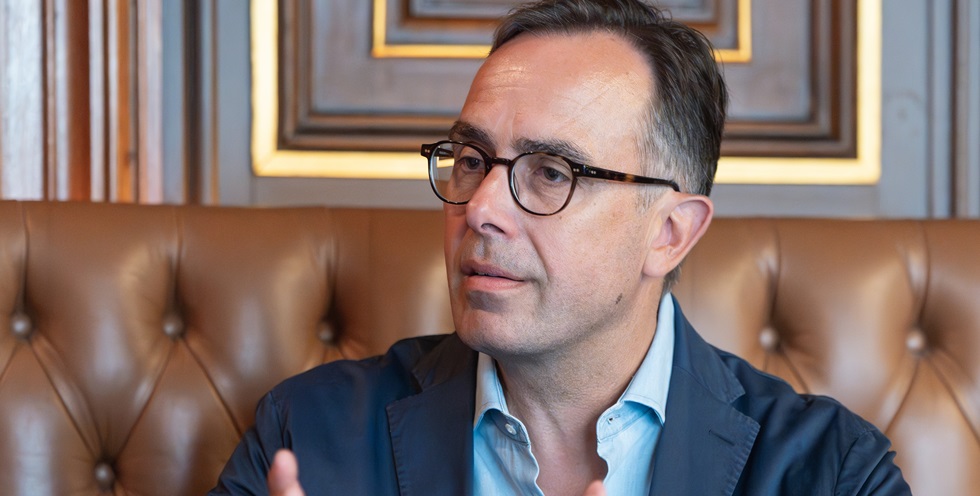
So, do you imagine a future with fewer but larger companies?
It’s hard for me to imagine large operators no longer dominating the market. They have the people, the resources, the technology, the market access... many of them have built a portfolio of brands in such a way that they don’t depend on just one, even if one is more important than the others. Additionally, they operate in a territory of good margins, but in the end, if they don’t appeal to consumers’ emotions, they may end up facing problems. With some exceptions, we’ve seen tough times for mid-market brands and quite a bit of consolidation. So again, size is not a guarantee of success in itself, but I firmly believe that it helps to have a certain critical mass and size to be more profitable because it generates economies of scale that smaller brands lack.
But fashion is about novelty. If only the big ones survive…
Fashion is about novelty, but it’s also about basics. People want to see novelty, but they lean towards basics. A friend of mine in the industry says that a brand must always have a connection with culture; there must be a moment when the brand has some relevance. The art is knowing how to maintain the brand’s connection with culture and remain relevant. For example, we’ve experienced a shift towards casual wear over the past ten or fifteen years. If you’re a formal fashion brand and haven’t adjusted your business model and offering, you’ve probably been declining over the past ten or fifteen years. Brands must adapt because, in the end, it’s about what consumers want and the major cultural trends that define it. With casual wear, we’ve also seen the streetwear trend, which was super popular for a while, but now it’s probably less relevant. If you’re a streetwear brand, you’ve probably had a fantastic few years, but if you don’t adapt now, you’ll struggle. The art lies in knowing how to be a brand and having the ability to adapt to consumers’ desires and general trends. That means that if you’re too niche, you run the risk of being just a temporary phenomenon. You need a certain breadth and depth of offering, and again, larger operators have more opportunities to do so.
“I find it hard to believe that large operators will stop dominating the market”
Is the future of fashion in volume or in value and margins?
The key is always in the value you create for the consumer, and depending on your position in the market, it could be higher or lower volume. Even in luxury, where exclusivity is supposedly the rule, we’re seeing brands that are incredibly large and operate at high volumes. In today’s market, those with higher demand are evolving better than the rest.
How will fashion be consumed in the future? Do you imagine a world with fewer stores? More? More digital?
It’s a great question to give an answer that will teach me in a few years that I was completely wrong. The reality is that we all underestimated the opportunity of e-commerce at first, but then we reached a phase, particularly during COVID, where the industry (and also consultants) overestimated the growth potential of e-commerce. In two years, e-commerce grew what it normally would have grown in a decade. Now we are in a tougher phase for e-commerce, where consumers have rediscovered their love for physical stores. If we believe in the idea that fashion is entertainment, at least in the Western world, then it makes a lot of sense that people want stores. But there are certain moments in a consumer's life when it’s easier and more convenient to shop online, although I think we will always have physical stores, and that’s why e-commerce is stagnating, albeit at a relatively high level. It would be easy now to say that the future is omnichannel, but we’ve been saying that for ten years. To be fair, there are very few operators who have developed a truly attractive omnichannel version.
The Red Sea, the situation in Bangladesh... How will fashion be produced in the future? Will the value chain change?
Actually, I think it has already changed. For two decades, we’ve had a deflationary market where production has moved from Europe to Eastern Europe or Asia, especially China. The sourcing caravan has always moved in search of countries with lower labor costs, but now it has stopped. In the past five to seven years, deflation has ended, and now we have inflation in production, which we’re probably not detecting now because we have some lack of demand and, therefore, more capacity than required, which gives power to brands. But the reality is that the expansion of production into Africa, which was so anticipated, hasn’t happened, meaning we have to deal with the capacity we have in China, Bangladesh, Vietnam, Pakistan, or India. So, production won’t get cheaper. Additionally, consumer and regulatory demands related to labor standards and sustainability will increase production costs. The industry needs to find a more sustainable way to produce because the footprint is too high. And let’s be realistic, the industry hasn’t yet addressed this issue. It frustrates me when people argue that even the big players can’t move until legislation arrives because it would put them at a disadvantage compared to unsustainable brands. I firmly believe that the super winners and large operators, who have the means and tools, shouldn’t wait for regulators. Because when has the regulator ever provided an efficient regulatory framework that benefited everyone? I’ve never seen it. We need to stop talking and start walking or running. 2030 is just around the corner.
Will all companies be able to adapt to the new situation?
Look at it this way: if the automotive industry can move from traditional engines to completely new ones, I think a relatively low-tech industry like fashion should be able to adapt. This industry doesn’t build rockets.
Do you imagine a circular future for fashion?
We must find one. We have limited opportunity for recycling, which means that if we want to manage the massive amounts of products entering the market every year, we must find a way to recycle them properly. We need to figure out how to manage garments made from multiple fibers, and we need to be able to handle the raw material flow with scalable technology that allows us to recycle materials. It’s unacceptable that only 1% of synthetic fibers are currently recycled. We should have seen more progress in this area.
“Consumers will end up paying more, but some margins will also adjust”
But even companies focused on developing scalable technologies are struggling. Who should pay for innovation?
In the end, it should be the consumer and, partly, the industry. In the medium or long term, we’ll see lower structural profitability in the sector.
And higher or lower prices?
Higher, for sure. And again, in a saturated market where volumes are falling anyway and where, for the first time, we’ve seen price increases in the last two or three years. Consumers will end up paying more, but some margins will also adjust for the better.
Fashion is becoming a regulated market. Can laws kill creativity?
Regulation should provide a framework, and as operators are asking, a level playing field for everyone. Regulation will serve that purpose and ensure that enough information and transparency is provided to consumers so they can make informed decisions. When I started in this industry, sustainability was little more than a code of conduct signed by most companies with their suppliers in Asia. It’s in the nature of this sector to produce in emerging markets with different regulatory frameworks, different living standards, and different working conditions, but things must improve, and I firmly believe that consumers will demand it and that regulators will bring more transparency. Consumers are complicated animals, and what they say is often different from what they do. But overall, I’m convinced that society is changing. We care about electric cars, we watch the food we buy... why should that stop at fashion? That’s where the digital product passport is leading us, providing more transparency, and consumers, particularly the most sophisticated ones, will make decisions based on that information. I’ve worked with many executives who are getting very serious about this issue, as are their employees and their children. So, in that sense, fashion will find the balance between growth and profitability and the demands of sustainability.
What advice would you give to a fashion company executive today?
If we’re talking about sustainability, I can understand that in the current market situation, it might seem easier to postpone some sustainability efforts, not increase budgets, and wait. But in my opinion, that would be a shortsighted decision because cultural change is coming, and consumers will respond positively to a commitment to sustainability, and in any case, regulation is coming. There are about sixteen laws in the European Union aimed at increasing sustainability scrutiny; some will be delayed, but they will come anyway. So, if you don’t want your business to be caught between a rock and a hard place, you’d better get serious about sustainability.
“If you don’t want your business to be caught between a rock and a hard place, you’d better get serious about sustainability”
What should a fashion company executive be like?
It’s not enough to be great at product and a solid retailer. When I started in this industry, there was a strong belief that if the product was spectacular, everything else would fall into place. But the industry has not only become more sophisticated but also more complicated. Therefore, as an executive, you must deal with a wider range of issues: internationalization, digitization, sustainability, diversity, inclusion... I firmly believe in art and science: you need the art, the creative energy, if you don’t want to sell commodities, but you must bring the necessary science to it all. And the truth is, nowadays, there are so many product development processes that are still done the way they were fifteen years ago... It’s funny to see everyone getting excited about Artificial Intelligence (AI), dreaming that it will be the solution to all problems. If we haven’t been able to use small and big data, I don’t think AI will solve anything... So, to answer your question, an executive today needs to have a relatively broad set of experts. As a CEO of a large company, you can’t be an expert in all areas. Nor should you be, because that leads to micromanagement. You need to build the right team to face the challenges but also to take advantage of the opportunities that arise. The positive side of the story is that there are many opportunities. It remains a sector with great margins. If a brand manages to hit the right note, if it has an amazing collection, if it runs an incredible campaign, it can generate business and excitement. And that’s what has always fascinated me about the fashion industry.
This interview was originally published in Spanish at Revista Modaes.








